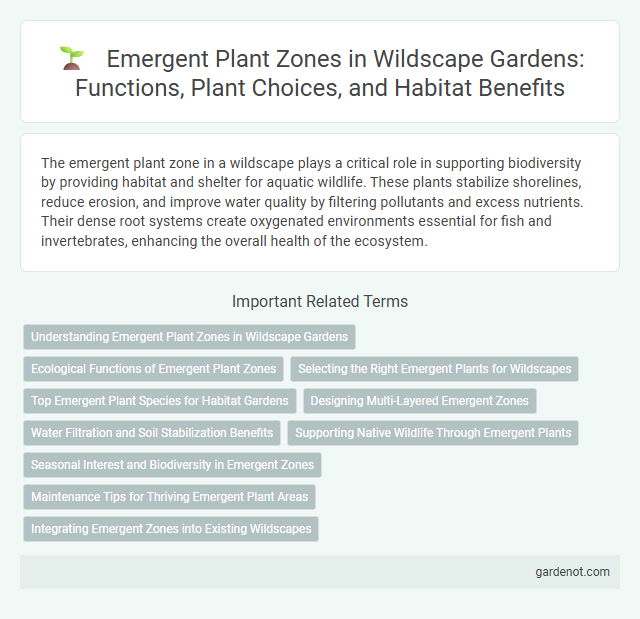The emergent plant zone in a wildscape plays a critical role in supporting biodiversity by providing habitat and shelter for aquatic wildlife. These plants stabilize shorelines, reduce erosion, and improve water quality by filtering pollutants and excess nutrients. Their dense root systems create oxygenated environments essential for fish and invertebrates, enhancing the overall health of the ecosystem.
Understanding Emergent Plant Zones in Wildscape Gardens
Emergent plant zones in Wildscape gardens consist of aquatic plants rooted underwater with stems and leaves emerging above the water surface, playing a critical role in ecosystem balance by providing habitat and improving water quality. Species such as cattails (Typha), bulrushes (Schoenoplectus), and pickerelweed (Pontederia cordata) thrive in these zones, offering shelter for wildlife and stabilizing shorelines. Proper understanding of hydrology, soil composition, and light requirements is essential for successful establishment and maintenance of emergent plant zones in sustainable wetland restoration projects.
Ecological Functions of Emergent Plant Zones
Emergent plant zones play a crucial role in wetland ecosystems by stabilizing shorelines and filtering pollutants, thereby improving water quality. These plants provide essential habitat and breeding grounds for various aquatic and terrestrial species, supporting biodiversity and promoting ecological balance. Their root systems enhance sediment retention, which helps reduce erosion and maintain nutrient cycling within the habitat.
Selecting the Right Emergent Plants for Wildscapes
Selecting the right emergent plants for wildscapes involves prioritizing native species that provide critical habitat and water filtration benefits. Species such as cattails, bulrushes, and pickerelweed thrive in wetland edges, enhancing biodiversity by supporting amphibians, birds, and aquatic insects. Proper selection ensures ecological balance, resilience to local climate conditions, and promotes natural water purification processes within the wildscape environment.
Top Emergent Plant Species for Habitat Gardens
Top emergent plant species for habitat gardens in Wildscape include Typha latifolia (broadleaf cattail), Schoenoplectus tabernaemontani (softstem bulrush), and Pontederia cordata (pickerelweed). These species provide essential habitat and nesting sites for wildlife while improving water quality through natural filtration. Their robust root systems stabilize pond edges and support diverse aquatic ecosystems.
Designing Multi-Layered Emergent Zones
Designing multi-layered emergent plant zones in Wildscape enhances habitat complexity by integrating diverse native species such as Typha latifolia, Scirpus validus, and Pontederia cordata. These layers provide critical nesting and feeding grounds for waterfowl and amphibians, improve water filtration through dense root systems, and stabilize shorelines against erosion. Strategic plant placement boosts biodiversity while supporting ecosystem services like nutrient cycling and habitat connectivity.
Water Filtration and Soil Stabilization Benefits
The Emergent plant zone plays a crucial role in water filtration by trapping sediments and absorbing excess nutrients, improving water quality in aquatic ecosystems. Its dense root systems enhance soil stabilization, preventing erosion and maintaining shoreline integrity. These plants support biodiversity by providing habitat while contributing to the overall health of wetland environments.
Supporting Native Wildlife Through Emergent Plants
Emergent plants in the Wildscape play a crucial role in supporting native wildlife by providing essential habitat, shelter, and breeding grounds for amphibians, birds, and aquatic insects. Species such as cattails, bulrushes, and sedges stabilize shorelines and improve water quality, creating a balanced ecosystem that fosters biodiversity. These plants act as natural filters and food sources, enhancing the overall health of wetland environments and encouraging the proliferation of native fauna.
Seasonal Interest and Biodiversity in Emergent Zones
Emergent plant zones provide essential seasonal interest through vibrant blooms and changing foliage that attract diverse wildlife throughout the year. These zones support a wide range of species, including amphibians, insects, and birds, fostering rich biodiversity in wetland ecosystems. Their complex root systems improve water quality and create critical habitat structures that sustain ecological balance.
Maintenance Tips for Thriving Emergent Plant Areas
Regularly remove decaying leaves and debris from emergent plant zones to prevent water contamination and promote healthy growth. Monitor water levels closely, ensuring consistent shallow depths between 4 to 12 inches for optimal root and stem development. Use natural pest control methods and avoid chemical fertilizers to maintain a balanced aquatic ecosystem and support plant vitality.
Integrating Emergent Zones into Existing Wildscapes
Integrating emergent plant zones into existing wildscapes enhances biodiversity by providing critical habitats for amphibians, waterfowl, and invertebrates while improving water quality through natural filtration. Strategic placement of native species such as cattails, bulrushes, and sedges stabilizes shorelines and promotes ecological balance in wetland ecosystems. This approach supports wildlife corridors and creates seamless transitions between aquatic and terrestrial habitats, fostering resilient and sustainable wildscapes.
Emergent plant zone Infographic

 gardenot.com
gardenot.com